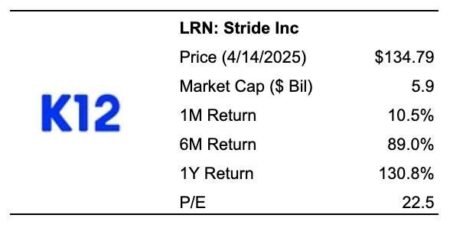Despite ongoing pressure in the broader markets from the U.S.-China trade war, RTX has demonstrated notable resilience, rising 10% this year. This outperformance can be partially credited to the distinct nature of the defense sector, which is often influenced by geopolitical dynamics and government contracts, making it less susceptible to widespread tariff impacts than commercial sectors. Additionally, Bloomberg reported that President Trump is expected to authorize a record-setting defense budget of approximately $1 trillion for 2026. Even after its recent rally, we believe RTX stock, trading around $125, still offers an attractive buying opportunity based on its fair valuation.
Our favorable view is based on a detailed analysis comparing RTX’s current valuation to its recent operational performance and financial condition, both current and historical. Across key metrics—Growth, Profitability, Financial Stability, and Downturn Resilience—RTX demonstrates moderate performance and financial health, further discussed below.
How Does RTX’s Valuation Look vs. The S&P 500?
Based on price metrics per dollar of sales or profit, RTX stock doesn’t appear overvalued relative to the broader market.
- RTX has a price-to-sales (P/S) ratio of 2.1 compared to 3.2 for the S&P 500
- Its price-to-operating income (P/EBIT) ratio is 25.9 versus 24.3 for the S&P 500
- Its price-to-earnings (P/E) ratio stands at 35.5 compared to 24.3 for the index
How Have RTX’s Revenues Grown Over Recent Years?
RTX’s Revenues have experienced strong growth over recent years.
- The company’s top line grew at an average annual rate of 8.0% over the past 3 years (vs. 6.3% for the S&P 500)
- Its revenues increased 17.1% from $69 billion to $81 billion in the past 12 months (vs. 5.2% growth for the S&P 500)
- Quarterly revenue rose 8.5% to $22 billion in the most recent quarter from $20 billion a year earlier (vs. 5.0% growth for the S&P 500)
How Profitable Is RTX?
RTX’s margins are around the median level relative to companies covered by Trefis.
- RTX’s Operating Income over the past four quarters was $6.5 billion, reflecting a moderate operating margin of 8.1% (vs. 13.0% for the S&P 500)
- RTX’s Operating Cash Flow during this period was $7.2 billion, yielding a moderate OCF-to-sales ratio of 8.9%(vs. 15.7% for the S&P 500)
Does RTX Look Financially Stable?
RTX’s financial position appears relatively weak.
- The company held $43 billion in debt at the end of the latest quarter, with a market cap of $170 billion (as of 4/10/2025), resulting in a moderate debt-to-equity ratio of 25.3% (vs. 19.0% for the S&P 500). [Note: A lower debt-to-equity ratio is generally preferred]
- Cash and equivalents totaled $5.6 billion out of $163 billion in total assets, giving a weak cash-to-assets ratio of 3.4% (vs. 14.8% for the S&P 500)
How Resilient Is RTX Stock During A Downturn?
RTX stock has performed slightly worse than the S&P 500 during past market downturns. Concerned about how it may fare in a crash? Our dashboard How Low Can RTX Stock Go In A Market Crash? offers an in-depth analysis. Also see past market crashes.
Inflation Shock (2022)
- RTX stock dropped 33.7% from a high of $104.66 on April 18, 2023, to $69.38 on October 5, 2023, vs. a 25.4%decline for the S&P 500
- The stock recovered to its pre-crisis peak by May 9, 2024
- Since then, it climbed to a high of $135.66 on March 25, 2025, and now trades near $125
Covid Pandemic (2020)
- RTX stock declined 52.2% from $91.87 on February 7, 2020, to $43.91 on March 23, 2020, vs. 33.9% for the S&P 500
- It fully rebounded by January 14, 2022
Global Financial Crisis (2008)
- RTX stock dropped 54.2% from $48.08 on October 1, 2007, to $22.00 on March 9, 2009, vs. 56.8% for the S&P 500
- It fully recovered by January 27, 2011
Putting All The Pieces Together: What It Means For RTX Stock
Here is how RTX performs across the parameters reviewed:
- Growth: Very Strong
- Profitability: Neutral
- Financial Stability: Weak
- Downturn Resilience: Neutral
- Overall: Neutral
Although RTX shows moderate performance across these categories, this appears to be reflected in its current valuation. The expected rise in defense spending should act as a significant growth driver for RTX moving forward.
While risks like supply chain issues due to tariff conflicts remain, we continue to believe RTX represents a solid buying opportunity at its current price of about $125.
But, if you aren’t too excited about RTX stock, consider the Trefis High Quality (HQ) Portfolio, with a collection of 30 stocks. It has a track record of comfortably outperforming the S&P 500 over the last four-year period. Why is that? As a group, HQ Portfolio stocks provided better returns with less risk versus the benchmark index; less of a roller-coaster ride as evident in HQ Portfolio performance metrics.
Invest with Trefis
Market Beating Portfolios | Rules-Based Wealth
Read the full article here
















